Royalty Meets Enterprise
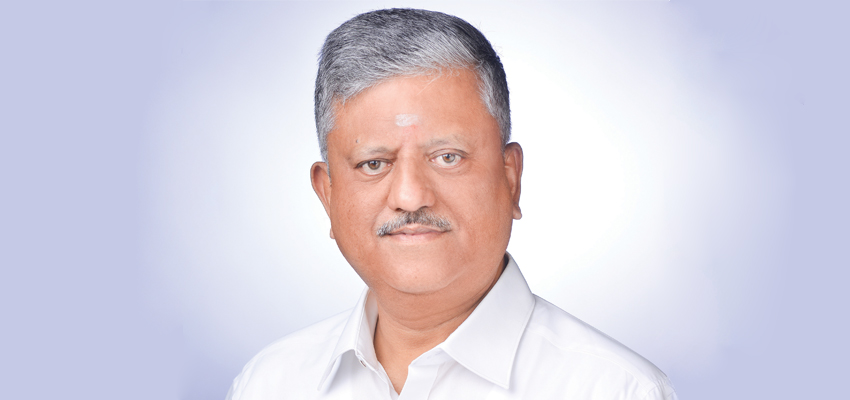
Thanjavur’s royal scion, Shrimant Babaji Rajah Bhonsle Chattrapathi, is a people’s person to the core with exceptional operational acumen, and is deeply committed to the preservation and rejuvenation of India’s rich cultural heritage. The current head of the Maratha royal family of Thanjavur and the titular king, Shrimant Babaji Rajah serves as the hereditary trustee of the Thanjavur Palace Devasthanam, which oversees 88 temples—including the UNESCO World Heritage Site, the Brihadeeswara Temple.
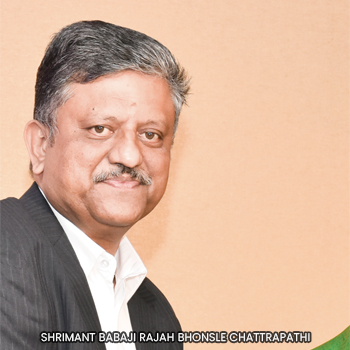
Motivated by challenges, Shrimant Babaji Rajah is a natural leader with an entrepreneurial spirit, embracing change and calculated risks to foster growth and create long-term value. He is the director - strategic alliances and growth, at PQSI Digital, a software product company focused on industrial digital transformation and AI.
In an exclusive conversation with Corporate Citizen, Shrimant Babaji Rajah reflects on the history and legacy of the Thanjavur Marathas, the inner workings of the royal office, his foray into entrepreneurship and technology, and his mission to build enduring relationships rooted in trust, empathy and honesty
Taking the mantle
Corporate Citizen: You were in your teens, when you lost your father and later grandfather, around 1984-1985, after which you took the task of managing 88 temples in Thanjavur district, under the Thanjavur Palace Devasthanam, of which you are the hereditary trustee. After taking the onus of these temples, you have orchestrated a positive turnaround, despite of facing many challenges. At such a tender age, how did you face the challenges and overcome them?
Shrimant Babaji Rajah Bhonsle Chattrapathi: Since the time of Chhatrapati Shivaji Maharaj, it has never been our legacy to inherit vast empires or indulge in grandeur passed down through generations. We built upon what little we had— with resolve, not with complaint. Whatever limited resources were available to us, our intent was always to develop, to uplift and to serve. I have closely observed the life of my grandfather and studied the Sarabhoji Charitra. Even during the reign of the Bhonsles of Thanjavur, the times were seldom easy. The circumstances were often adverse, but our forefathers persevered. Their achievements during those turbulent years, stand as a testament to the divine grace and unwavering trust of the people.
As for my own journey—it is the people’s faith and support that I credit for the turning points in my life.
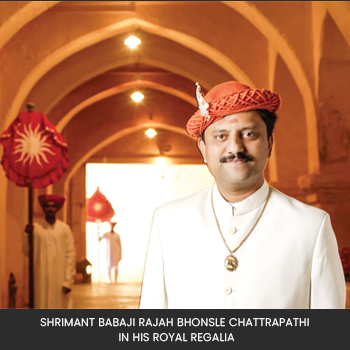
I was but fifteen, a minor, when I lost my father. Within nine months, my grandfather too departed. I was still in the 10th Standard, and had to complete my education through the 11th and 12th standard, without the experience or readiness to assume royal responsibilities. During this time, my uncle managed the affairs of the royal office for a year-and-a-half. I had no formal training then, but guided by intuition and the counsel of my grandfather’s close associates, I began to act. The world around me, too, was evolving. The people were beginning to expect my presence and involvement in the affairs of our temples.
At my core, I am self-driven—that has been my foundation. I witnessed firsthand, how tirelessly my grandfather worked—he never waited for perfect conditions; he made them. We believed deeply in what we undertook, and we pursued it with unwavering determination. Every initiative we took was rooted in Dharma—be it for religious or social causes. Never was there a personal agenda behind our efforts. And, perhaps that is why the people aligned naturally with us—they saw clarity, sincerity and purpose, in our actions.
"We have never carried ourselves as royals set above others. Royalty, for us, is an inheritance—not a badge to flaunt. So, there’s no need for us to go about saying ‘I did this’ or ‘I achieved that’. Whatever we are able to do today is only because of the blessings and support of so many people around us"
— Shrimant Babaji Rajah Bhonsle Chattrapathi
Throughout this journey, Aai Saheb, Rajamata Vijaya Raje Bhonsle stood like a rock. Her strength and grace gave me the courage to face every adversity. Aai Saheb’s tireless devotion to the temples, especially the Sri. Chandramouleeswara Temple, continues to be an enduring inspiration for me.
I also owe a deep sense of gratitude to Pujiya Sri Dayananda Saraswathi Swamiji, whose wisdom and guidance profoundly shaped my spiritual path.
We always knew what we were doing and why we were doing it. And, we committed ourselves to it with diligence and resolve.
Remembering history and honouring culture
CC: There is a Maharashtrian population in Thanjavur, who over the time, have properly gelled with the Tamil culture and people. Known as Tanjore Maharashtrians, they speak a dialect called Thanjavur Marathi (Dakshini Marathi), a mix of Marathi and Tamil. Tell us a bit about their significance, history, and how they have contributed greatly towards the betterment of the people of Tamil Nadu.
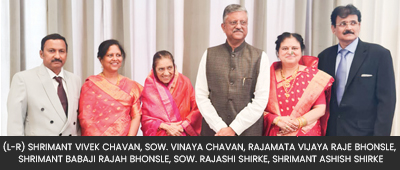
From the very day the Marathas set foot in this land, we were seen as sugar in the milk— blending seamlessly, and enriching the culture. Since the time of Emperor Rajaraja Chola, wherever he unfurled his banner, the land became his own. Such was his might. Yet, during the Nayaka period, the tides had changed. Even the sacred Brihadeeswara Temple— Rajarajeesvaram—required fortification with walls and ramparts. It was a period when foreign invaders posed grave threats to our civilisational icons. The Nayakas bore the burden of resisting cultural erosion and halting desecration. And then, destiny turned the wheel—it became the duty of the Marathas to uphold this legacy.
During the reign of Serfoji II, the last sovereign ruler of the Thanjavur Maratha principality, circumstances had deteriorated. The French and British forces had occupied the Brihadeeswara Temple, reducing it to a mere garrison. It was Serfoji II who compelled their exit through negotiation, restoring sanctity to that hallowed ground. He stood firm against British tyranny. I, today, stand as the sixth descendant in his illustrious line. Serfoji II not only reclaimed the temple from foreign hands, but also reinvigorated it—renovating, reconsecrating, and gifting it with gold and silver ornaments. His contributions revived the spiritual grandeur of the temple.
The Marathas have made monumental contributions to the cultural and social fabric of Thanjavur. Over time, we did not remain outsiders—we became one with the native Tamils. This is Chola soil, and even Serfoji himself referred to it with reverence as such. The land once lay vulnerable, without guardians. We became its custodians. We did not merely defend this heritage—we nurtured it, fortified it, and gently infused it with the essence of our own tradition. The assimilation was natural, harmonious and complete. That is the true greatness of the Marathas of Thanjavur.
"One advantage I have—something I truly consider a blessing—is being born into a legacy, into a dynastic family that has been closely associated with the cultural and spiritual life of this land. This inheritance allows me the opportunity to serve as a custodian of several historic temples"
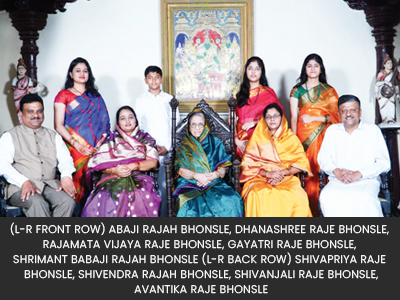
Our arrival in this region followed two principal routes. One led through Bengaluru, Hosur, Krishnagiri, Dharmapuri, Salem, Tiruchirappalli, and finally Thanjavur. Tiruchirappalli, for a time, came under the influence of the Ghorpades. The second route began from Kolar and extended through Vellore, Arani, Gingee, Tiruvannamalai, Valikandapuram. Gingee itself, at one point, served as a Maratha stronghold under Rajaram, the valiant son of Chhatrapati Shivaji Maharaj. Wherever our people halted, they established settlements—firm, organised, and loyal to the cause. Even today, if one travels from Thanjavur to Bengaluru, every forty kilometres, one will find traces of Maratha presence.
Once settled in Thanjavur, our community extended its influence to the sacred town of Rameswaram. The Maratha kings established Chatrams (rest houses) throughout Mayiladuthurai and Rameswaram, ensuring comfort for pilgrims and travellers. The silver chariot of the Avudaiyar Temple at Avudaiyarkoil was gifted by our family—a symbol of our devotion and patronage. We exercised control and guardianship across the entire coastal stretch.
Importantly, our royal family was not alone in this mission. The Sardars, our trusted generals, who accompanied us, were entrusted with the care of surrounding temples. These families maintained, managed and enriched temple life. Culture and religion remained our highest priorities.
We have not merely lived in this land—we have served it, preserved it and honoured its soul.
CC: What is Thanjavur’s connection to Chhatrapati Shivaji Maharaj?
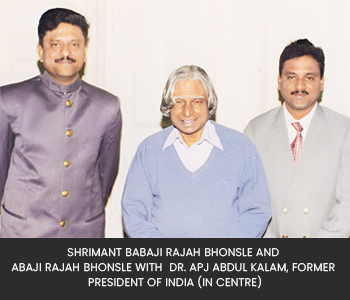
Chhatrapati Shivaji Maharaj was the illustrious son of Shahajiraje Bhonsale and Rajmata Jijabai—a union that gave rise to one of the greatest sons of Bharat. The eldest among their children was Sambhaji Shahaji Bhonsale, the elder brother of Chhatrapati Shivaji Maharaj. Venkoji Rajah Bhonsle, my direct ancestor, was born to Shahaji Maharaj and his second consort, Tukabai, who resided with him in Bengaluru. Chhatrapati Shivaji Maharaj and Venkoji Rajah were half-brothers—bound by the same father, but born of different mothers. It was Venkoji Rajah bhonsle who laid the foundations of the Thanjavur Maratha dynasty in the year 1676. We are proud descendants of that noble lineage.
As for my immediate family, I have two sisters and one younger brother. Beyond them, we maintain a closely bonded extended family of nearly eighty members residing here in Thanjavur, including my paternal uncles and their households.
My wife, Gayatri Raje, hails from the royal house of Baroda. Together, we are blessed with three children. Our elder daughter, ShivanjaliRaje, is a practicing medical doctor based in Coimbatore. Our second daughter, Avantika Raje, is an architect shaping her path in Bengaluru. Our youngest, Shivendra Rajah, is presently in his third year of B.Com studies, also in Coimbatore.
Ours is a family rooted in tradition, bound by duty, and committed to service— both to the people and to the enduring legacy of our forebears.
My journey with technology and entrepreneurship
CC: You have a civil engineering degree. Tell us a bit about your educational journey. Why did you take to civil engineering?
My uncle was a civil engineer by profession, and naturally, he was keen that I follow a similar path. During my formative years, he strongly encouraged me to pursue engineering. At the time I undertook my civil engineering studies, computer science had not yet emerged as a mainstream discipline.
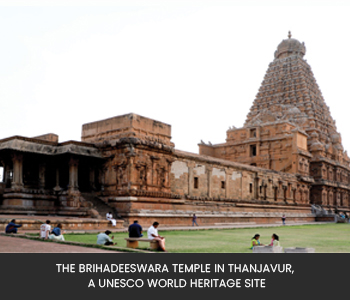
However, as fate would have it, I soon found myself immersed in my inherited responsibilities—called upon to uphold the duties of our lineage. The obligations before me left little room to explore entrepreneurship or venture into the world of business. Nevertheless, I have always nurtured an inquisitive mind and a deep interest in emerging technologies.
Whenever new tools or innovations presented themselves, I made a conscious effort to understand and adopt them. I recall the arrival of Microsoft Excel, when spreadsheet software was still new to most—I took it upon myself to learn it. I immediately recognised its potential and began applying it to administrative work in our temple office.
Naturally, introducing such change was met with resistance. The royal office staff, accustomed to traditional ledgers and manual bookkeeping, were hesitant at first. But, I remained firm in my conviction, and with time, they too began to see the efficiency and clarity it brought.
I also introduced Closed User Group (CUG) mobile phones for the office staff, ensuring streamlined communication and immediate accessibility. These small yet significant changes brought a sense of modernity to our functioning, without compromising the traditional values we uphold.
In my view, embracing technology where appropriate, is not a departure from heritage, it is a means to strengthen and serve it better.
"My journey in technology and entrepreneurship has been one of constant learning, guided by discipline, curiosity, and a commitment to excellence—values that are consistent with my lineage and personal philosophy"
CC: You are a cofounder of two IT companies in Chennai. So, tell us about the corporate role you play.
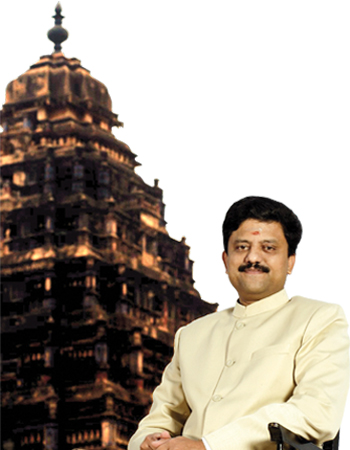
One of my close associates introduced me to the world of Information Technology, and that marked the beginning of my entrepreneurial journey in this space. Together, we established a company called Exinfotech, which initially focused on building Customer Relationship Management (CRM) software. Over time, our operations organically diversified into the domain of ePublishing. This gradual foray into the digital realm marked my deeper engagement with technology.
Prior to this, what I implemented at the temple in Thanjavur was a structured exercise in administrative management—executed with clarity and purpose, and aligned with the needs of the time. My technological pursuits, however, stemmed from an inner drive—a persistent curiosity to learn, adapt and innovate. As my journey progressed, I became actively involved in an ERP (Enterprise Resource Planning) software solutions firm, and began offering consulting services in the realm of Productive Management Systems.
My journey with technology and entrepreneurship has been one of constant learning, guided by discipline, curiosity, and a commitment to excellence—values that are consistent with my lineage and personal philosophy.
Despite not having formal certifications, my understanding of technology and management has come through hands-on experience— learning from my friends, collaborators, and through real-world challenges. Starting with CRM and ERP, manufacturing and consulting came as a natural progression.
During our consultations on industrial shopfloors, I began to repeatedly encounter the emerging buzzwords “Industry 4.0” and “IoT”. Recognising the strategic importance of these technologies, I initiated discussions with peers and sought out deeper knowledge in this domain. This quest led me to PQSI Digital, founded by Shri Venkat Krishna—a visionary in industrial digital transformation. He extended an offer of partnership, which I accepted after discerning alignment in vision and capability. Our shared mission is to scale and expand the business meaningfully. We have recently taken a significant step by bringing onboard a strategic investor to accelerate and drive our growth in this space.
Manufacturing companies invest budgets and efforts in data, and face challenges in deriving results. PQSI Digital and our product is focused in bringing the data together, and deliver actionable insights with AI and IoT. By bringing reliable information in real time, we enable users to focus on outcomes and profits. Today, the product has been successfully deployed across 25+ industrial sites, including renowned organisations like Ashok Leyland, Brakes India, Birla Cement and Pricol Limited.
"I have always nurtured an inquisitive mind and a deep interest in emerging technologies. In my view, embracing technology where appropriate is not a departure from heritage—it is a means to strengthen and serve it better"
Rejuvenation and restoration of heritage and culture
CC: Preserving heritage structure requires funds, requires a balancing act, where modern things should not get over it. And, you are also a convener in Indian National Trust for Art and Cultural Heritage (INTACH) Thanjavur Chapter, an organisation focused on preserving and promoting India’s art and cultural heritage. With so many heritage structures in and around Thanjavur, how do you manage to preserve them, and what initiatives do you take to keep it intact?
There have always been trade-offs to navigate in heritage conservation. A very close family friend, who supports our family, Shri Shankar Vanavarayar, played a pivotal role in helping establish the INTACH Thanjavur Chapter. At one point, the palace was under the management of the Public Works Department (PWD), and their standard approach to renovation was disheartening. They would arrive with grey paints and modern tiles, claiming those were the only permissible materials as per the prevailing norms. It was a constant struggle to convince the engineers and officials, not to use these materials, which were entirely unsuited for heritage structures. We must have raised this concern with the authorities’ countless times.
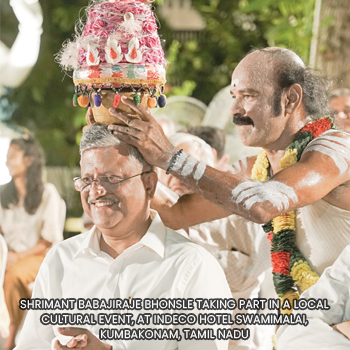
One advantage I have—something I truly consider a blessing-is being born into a legacy, into a dynastic family that has been closely associated with the cultural and spiritual life of this land. This inheritance allows me the opportunity to serve as a custodian of several historic temples, foremost among them being the Brihadeeswara Temple, a UNESCO World Heritage Site and a monument under the purview of the Archaeological Survey of India (ASI). I’ve always taken a keen interest in observing and understanding the processes of conservation and preservation they follow.
In earlier years, the approach was purely about preservation—essentially maintaining structures in their current state. But, when it comes to temples, I strongly believe it must go beyond that—it must include Punarudharanam, which is rejuvenation and restoration in its truest sense. This perspective, however, was often not easily accepted by the authorities. So, I had to begin negotiating the fine line between public sentiment, contemporary necessities, and the strict protocols of institutions like ASI and UNESCO.
When it came to the palace, the situation was even more complex. The PWD had no expertise in heritage architecture, and treated it like any other modern government building. That’s when we reached out to the state convener of INTACH and began dialogues. Gradually, through these engagements, a dedicated heritage wing was created within the PWD itself. Today, they are far more informed and sensitive to the requirements of heritage restoration.
Even in temples now, the insertion of modern elements is strictly regulated. Any work we do must respect the original aesthetic and architectural language of the space. One principle we have adopted is that of least intervention. And, whatever is done must be reversible. If an addition proves to be inconsistent or inappropriate, it should be removable without causing any damage to the original structure.
In modern times, we do face the practical necessity of adding certain utilities—CCTV cameras, restrooms, wiring for lights or sound. But, each of these decisions must be made thoughtfully, with cultural and historical sensitivity.
CC: What I have observed is that, there is no ticket or entrance charge, to visit these heritage temples in Thanjavur. Even for a World Heritage Site like the Brihadeeswara Temple, there is no entrance fee, and there are no special VIP passes as well. You say that temples are not to be seen just from the architectural viewpoint, but also as a place of worship. But then, how do you source the funds to maintain so many temples?
The temple is a space where values are preached, knowledge is shared, and wealth is disseminated. It remains one of the few places where the principle of fairness can truly be practiced on a level playing field. My grandfather too, was hesitant to impose any entrance fees, because a temple is not a commercial place, but a space of grace. In my view, blindfolded Bhakti alone is not enough; without values and awareness, devotion loses its purpose. So, in everything we do, our aim is to restore and reawaken that deeper sense of value.
Ultimately, the temple belongs to the people. They are its true custodians. It’s perfectly fine for our family to continue in a leadership role, but the ownership of the temple, of the culture, must rest with the people. That is what I’m deeply invested in nurturing—encouraging people from all walks of life to come together, to step up and take charge of preserving our cultural and spiritual heritage. It’s not the responsibility of a single person or a single family—it belongs to all of us.
When it comes to maintaining and managing these historic temples, a good portion of land was endowed to them, and we focus on optimising the income generated from these lands. At the same time, if someone wishes to contribute voluntarily to the cause, we wholeheartedly welcome their support.
CC: Besides the World Heritage Sites under UNESCO in India, that are protected under an international treaty, there exists no specific national statute for the protection of intangible cultural heritage.
First and foremost, there must be close and coordinated efforts between the ASI, the Hindu Religious and Charitable Endowments Department, local body administration, district administration, and the tourism department. At present, this synergy is lacking. Secondly, organisations like INTACH, which facilitate public participation, must work symbiotically with both the government and the local communities. Thirdly, it is imperative to create awareness among people about the need to protect and take pride in their own heritage and culture. A concerted effort is required from both the Central and State governments, coupled with strong public-private partnerships. Only then can we harmoniously combine development with heritage preservation and instil in the younger generation a deeper appreciation and understanding of our shared history.
"The Thanjavur Palace Devasthanam today comprises 88 temples under its fold, including significant sites like the Brihadeeswara Temple in Thanjavur, Iravatheswarar Temple in Darasuram, Punainallur Mariamman Temple and the Thanjai Mamani Koil, one of the 108 Divya Desams of the Vaishnavite tradition. Each of these temples is not just a place of worship but a living testimony to the layered heritage of this land, and it is our solemn duty to protect and uphold their legacy with utmost integrity"
People’s person
CC: You are a people’s person and a human resource manager, with a very good connection with people. You have taken health insurance for all the service persons, including the priests, connected with the temple office. You have setup makeshift hospitals during Covid-19 pandemic. Does empathy play a big role in human relationship and administration?
Even before any function took place in our palace, my grandfather would ensure that all the staff had their meals first—his philosophy was simple: when they are cared for, they will serve the guests with joy. That spirit of empathy is something I have always carried forward.
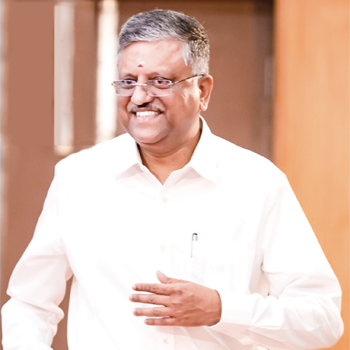
During the Covid-19 pandemic, I didn’t stay indoors. I was constantly out on the ground, helping people, making arrangements, and ensuring, the situation was being tackled responsibly. I attended few funerals, stood by grieving families, and coordinated daily online meetings to keep things moving. With temples closed as per government orders, there was growing psychological distress among people. I had to have difficult conversations with the assistant commissioner. While devotees were not allowed inside, the priests continued performing the daily rituals. I argued that if poojas were ongoing, people should at least be allowed to witness them from a safe distance outside the temple—because for many, faith was the only solace. Shutting the doors of the temple meant shutting the door to their emotional anchor.
At a time when most people didn’t know what tomorrow held, they needed not just help, but hope. We provided both—through direct financial support and with the help of friends who contributed materials and basic necessities for relief work. Empathy, after all, lies at the heart of both administration and human relationships. Without it, even the best systems can fall short.
"As far as political aspirations are concerned— it simply doesn’t align with our way of thinking. Power politics has never appealed to me. I don’t believe one needs a political position to serve the people. I am content and committed to doing whatever is possible from where I stand"
Enduring legacy
CC: You have stated in your earlier interviews that your wife has been a great source of strength during your challenging times.
My wife, Gayatri Raje, hails from the royal house of Baroda—a land steeped in culture and tradition. Though equally devout and conservative, Baroda and Thanjavur are culturally distinct in language, customs and way of life. In our family tradition, the men have historically remained occupied with temple duties, community responsibilities or ceremonial functions, seldom involving themselves in the domestic domain.
When Gayatri Raje first arrived in Thanjavur, she encountered several challenges—foremost among them being the language barrier, which made even basic communication with the palace staff difficult. Yet, with quiet determination and dignity, she overcame these hurdles and steadily adapted to the ethos of Thanjavur and its expectations.
Over the years, Gayatri Raje took complete charge of the household, and brought up our children with care and discipline, enabling me to focus wholly on my duties in the public sphere—engaging with the people, resolving their concerns, and upholding the legacy of our lineage.
Now that our children are grown and pursuing their own paths, Gayatri Raje has gracefully taken on new responsibilities. Alongside her household duties, she now actively represents the palace in various cultural, artistic and academic collaborations. Whether it is supporting traditional arts, partnering with institutions, or contributing to meaningful initiatives, she continues to serve the larger cultural mission of our family, with the same devotion she has always shown at home.
Ours is a life grounded in simplicity, inner contentment, and unwavering adherence to traditional values. We remain distant from material excess and transient pleasures, holding fast to the ideals of purpose, dignity and service.
CC: You were greatly influenced by your grandfather in both human relationships and administration. Are your children—the next generation—showing the same interest to get involved with human relationship and administration?
I believe the next generation’s outlook towards the world is markedly different from ours. In many ways, I feel they are likely to develop a deeper emotional connection with people than perhaps I ever could. That is not to say we lacked empathy, but our circumstances were defined by struggle, by a lack of time and comfort. We were shaped by duty, not by leisure.
They, however, have the advantage of stability and access, which allows them to approach the same responsibilities with joy and enthusiasm.
CC: You are playing a leading role in preservation and rejuvenation of these heritage structures and temples. Are you grooming your children to work for the same cause and take the lead, as you are doing it?
Surely, they are showing genuine interest. Whenever they are in Thanjavur—be it for a cultural event, a religious festival or any community gathering—they wholeheartedly participate and immerse themselves in the traditions of our land. They engage with the people, observe the customs, and uphold the very way of life they have grown up around. Naturally, they are following in my footsteps, and I see in them the same sense of responsibility and reverence for our shared heritage. It is heartening to witness this continuity take root in the next generation.
CC: You are very busy every day serving the people of Thanjavur. Through such hectic work schedule of yours, how do you balance your work-life and give time to your family?
My wife and children understand the responsibility I carry towards the people and the society. They have always supported me in this journey. My mother, Vijaya Raje Bhonsle, my brother, Abaji Rajah Bhonsle, and my wife, Gayatri Raje Bhonsle, shoulder the overall management and operations of the royal household with dedication and grace. Their quiet strength and support have allowed me to focus on the larger responsibilities that come with our legacy.
I am equally indebted to my sisters, brothersin-law and immediate family, whose unwavering support has been my strength through every phase of life. Many friends, philanthropic individuals and upright officers, have stood by me with conviction and compassion. They have been my backbone—and to each of them, I wholeheartedly dedicate whatever success I have been able to achieve. Their presence in my life has been nothing short of a blessing.
"Ultimately, the temple belongs to the people. They are its true custodians. It’s perfectly fine for our family to continue in a leadership role, but the ownership—of the temple, of the culture— must rest with the people. That is what I’m deeply invested in nurturing"
CC: Do you keep in touch with your kins in Satara and Kolhapur, in Maharashtra?
Yes, we maintain a warm and respectful connection with our kins in Kolhapur, Satara and Nagpur. We often visit Kolhapur and Satara, and they, in turn, visit us here in Thanjavur. These ties are rooted in shared history and mutual regard, and we cherish the continued bond between our families.
CC: Like your kins in Maharashtra, you have not taken the political path to power and economics? As a royal politician, you could have brought a mix of heritage, tradition and modern political strategies, influencing India’s political scene in significant ways.
If you go back into the history of Venkoji Rajah Bhonsle, the founder of the Maratha rule in Thanjavur, there comes a point in his life when he chose Vanaprastha, a conscious withdrawal from worldly responsibilities. He disowned everything, embracing detachment. That way of thinking has always been embedded in our family’s ethos.
Even during times of great turmoil, my forefathers stood their ground—fighting tooth and nail against British interference. They ensured that the Chatrams, the temples and the royal library, remained untouched— that they were neither shut down nor taken away to London. That deep-rooted commitment to serve the people has always defined our family’s identity.
We have never carried ourselves as royals set above others. Royalty, for us, is an inheritance—not a badge to flaunt. So, there’s no need for us to go about saying ‘I did this’ or ‘I achieved that’. Whatever we are able to do today, is only because of the blessings and support of so many people around us.
And, as far as political aspirations are concerned, it simply doesn’t align with our way of thinking. Power politics has never appealed to me. I don’t believe one needs a political position to serve the people. I am content and committed to doing whatever is possible from where I stand.
Lessons for the new generation
CC: What are the success mantras you would like to give to the next generation, to continue the work that you are doing?
The foremost principle is to approach this work of preservation and rejuvenation with a sense of duty. If one begins by asking, “Why should I do this?” or “What’s in it for me?”, then the purpose is already lost. This is not a burden to be carried like extra luggage—it must be embraced as one’s Dharma.
Secondly, cultivate genuine relationships with the people around you. It is only through connection and empathy that meaningful service can be rendered.
Third, develop patience, perseverance and resilience. These are not just virtues, but the foundation upon which long-term responsibilities are sustained.
And finally, don’t seek ownership. I believe in practising the subtle art of attachment to detachment—when you give your all, yet remain unattached, life flows more peacefully. It shields you from the hurt that comes from expectations, and allows you to serve with clarity and grace.